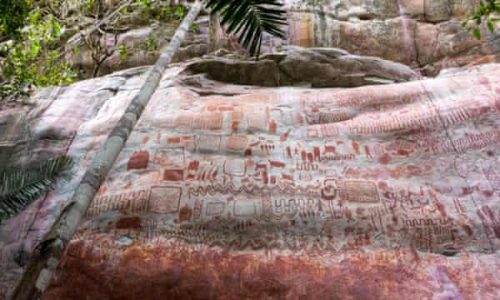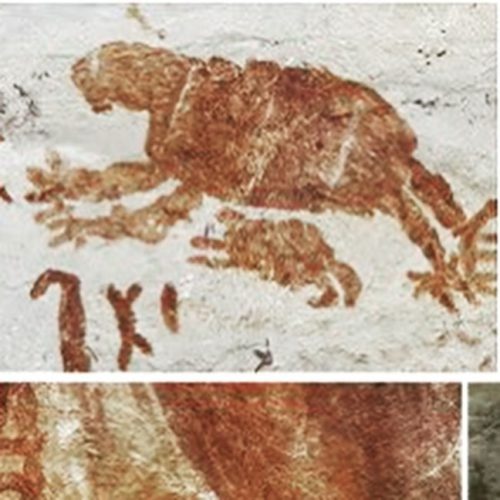Tantalizing. I keep seeing news about the discovery of a massive cliff face in a remote part of central Colombia that is covered with ancient rock art. This would be really cool, except that I’m feeling suspicious and skeptical. But look at this image! I want it to be true.
There are a few reasons I’m dubious right now. I don’t doubt that the rock art is there, but I’m seeing claims that it’s between 20,000 (as reported in 2015) and 12,500 years old. What I’m not seeing is citations to the scientific literature. The recent surge in interest seems to be fueled by the upcoming release of a television program on UK Channel 4. For all I know, that could be equivalent to an announcement that it’s going to be on the History channel, which would tell me it’s garbage and hype. Does anyone know if there is a paper in an archaeology journal about it?
I just like the idea of seeing more art by witnesses to Giant Ground Sloths.




According to the story in The Guardian, “The discovery was made by a British-Colombian team, funded by the European Research Council. Its leader is José Iriarte, professor of archaeology at Exeter University and a leading expert on the Amazon and pre-Columbian history.” That sounds pretty legit.
A typical chupachabra…
cervantes @1
Yeah, that was my impression too. If you look up Prof. Iriarte, you come across his website, which looks pretty typical for an established archeologist. I’d bet on this guy being legit. It’s also worth noting that the statements associated with him and his team seems to place the site’s date at about 12,500 years old (i.e., about 10,500 BCE) which is not out of line with current ideas about human migration into the Americas. So, while the journalists may be doing the sensationalism thing with this, the actual scientists seem to be pretty firmly rooted in proper archeology.
How wicked cool is that? I get excited when viewing small rock art panels in the US southwest. This is orders of magnitude greater than those, not to mention being 10000+ years older.
dammit. I told the kids not to paint on the rocks unless it’s tempera.
JUST to me, it seems too clean and orderly. I’ve done some half dozen or so site surveys in the southwest ( New Mexico and west Texas) and have never seen this clarity or organisation. I am NOT an expert by any means nor am I acquainted with Central or South American examples. It just seems too neat.
The two stories refer to different locations, I think.
Ground sloth? Nahh, that’s clearly the Grand Colombian Turtle-Puma.
To me, that photo looks like a blanket, or sheet with printing on it has been carefully draped over the rock. I’d like to see a high-res close-up photo.
Seems to be a rough neighborhood. And after 50 years, the guys with guns seem to have settled down for the time being.
Armadillo-panther-man.
I’ve got issue #1 in near mint, if you’re interested.
Is there any explanation for how these things were preserved for so long? It’s one thing to find something like this in a cave or some other relatively sheltered, dry environment, but out in the open, in a rainforest?
Also that is clearly a giant naked mole rat.
If only it were so!
@2, Birger: The word is chupacabras /tʃupakabras/. Chupacabra (q.v. is a Regularization (q.v.) I am quite fond of these typically Spanish nouns, consisting of verb+subject: a corkscrew screws corks: un sacacorchos.
And then there is a catholic Saint James, the matamoros.
That’s what I thought at first. But if you look at the photos in the article that’s a result of scale. That photo looks like it is about 6 feet by 3 feet making this look like dubious circuit board precision but in actually it more like 60 feet by 20 feet.
I’m wondering aren’t there radio-dating methods to determine the age? (Not rhetorical; I don’t know if there are or not or how practical it is to do them). The reasoning, “we date it to be 20,000 years old because it depicts mastodons” seems a little backwards to me.
José Iriarte
Well, you can always check his citation index;
https://scholar.google.com/citations?user=JtKFXhoAAAAJ&hl=en
woozy @17:
From the first linked article
#17 – Presumably, if there are organic compounds mixed in with the pigment(s), such as fats used as binder, one could obtain a C14 date. But you’d have to destroy a small amount of an image to get material to date. If the rock is sandstone, that could be tricky, as pigment adheres to facets of sand particles, making it difficult to get enough material. Then, you’d either assume the images are contemporary with one another; or take samples from several to many images to obtain enough comparative/corrobative data.
Wow, and just a over a month from finding this large cat in Peru:
https://arstechnica.com/science/2020/10/a-giant-cat-picture-was-just-discovered-among-the-nazca-lines/
I’m a bit wary of the date, which can only I think be a guess, and rock art analysts tend to want to “think” their art is old. It does seem an odd place to get such apparently good survival. Dating of art is possible in relative terms (eg where different styles have been painted over each other). Dating without organic pigments is possible in dry areas from memory, by analysing the coating of “desert varnish” but that doesn’t apply here. Also sometimes possible to get rough dates if the art extends below present ground level and you can date the sediments, But PZ, I am always very very wary of attempts to identify extinct megafauna in rock art…
I’ve seen rock art in Australia with several serial bands or drawings arranged vertically, but never anything this dense. There is no reason not to fill the rock wall like this, assuming one has a place to stand while painting and the images can be seen by whatever audience. In this case, the painter would need a ladder or scaffold, but the layout, density and relative inaccessibility has me imagining a “reader” on a ladder recounting stories to a gathering.
In Australia, they dated some of the paintings based on carbon dating of a 9000+ year old wasps’ nest built over some of the art. There may be old organic material deposited on parts of these paintings. Carbon dating can now work with really small samples, so we’ll probably get some believable dates soon.
I think this may be an initial paper, from April this year:
https://www.sciencedirect.com/science/article/abs/pii/S1040618220301907
Quaternary International
Colonisation and early peopling of the Colombian Amazon during the Late Pleistocene and the Early Holocene: New evidence from La Serranía La Lindosa
Author Gaspar Morcote-Ríos Francisco Javier Aceituno José Iriarte MarkRobinson Jeison L.Chaparro-Cárdenas
Recent research carried out in the Serranía La Lindosa (Department of Guaviare) provides archaeological evidence of the colonisation of the northwest Colombian Amazon during the Late Pleistocene. Preliminary excavations were conducted at Cerro Azul, Limoncillos and Cerro Montoya archaeological sites in Guaviare Department, Colombia. Contemporary dates at the three separate rock shelters establish initial colonisation of the region between ~12,600 and ~11,800 cal BP. The contexts also yielded thousands of remains of fauna, flora, lithic artefacts and mineral pigments, associated with extensive and spectacular rock pictographs that adorn the rock shelter walls. This article presents the first data from the region, dating the timing of colonisation, describing subsistence strategies, and examines human adaptation to these transitioning landscapes. The results increase our understanding of the global expansion of human populations, enabling assessment of key interactions between people and the environment that appear to have lasting repercussions for one of the most important and biologically diverse ecosystems in the world.
My first thought was “there is no way can any paint survive exposed to a rainforest for 15,000 years”.
My second thought was: “What kind of substrate is that on? because it must be an incredibly durable surface. The Egyptian pyramids are only 4,000 years old and the entire surface has eroded away. (The pyramids were once flat.)
Whatever chemical concoction was used to make those images is definitely not OSHA approved.
@25 Seems like a valid point to me.
As for Egyptian pyramids, they were originally clad in nicely cut and finished casing stones, some of which were dislodged by earthquakes and some stripped away over time for other building projects.